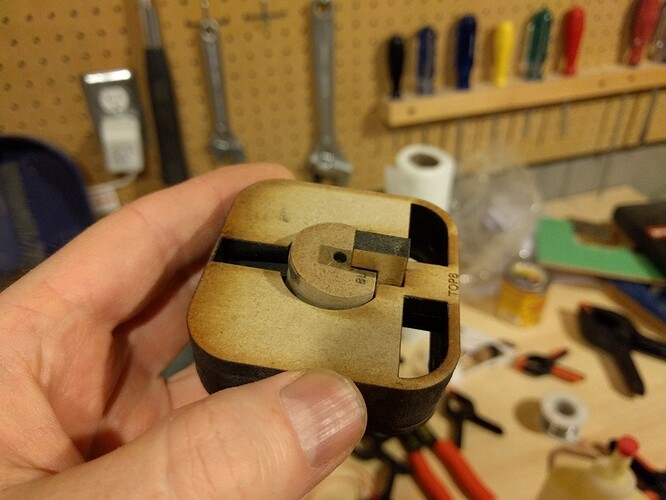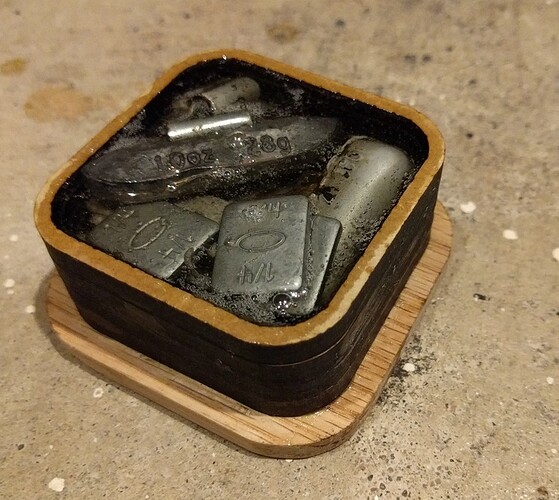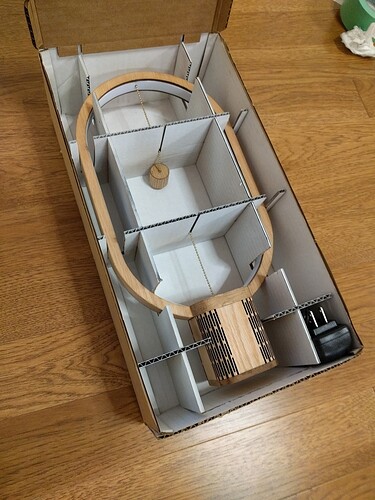This is, shall we say, heavily inspired by the Heng Balance Lamp:
The lamp features two “corks” with rare earth magnets inside that float in opposition to each other. If you separate the corks, the bottom one will fall, and the light will turn off.
(Edit: Plans and assembly instructions are here.)
I was hunting around for a second project to attempt on my GlowForge. I have some 3D modeling experience, but nothing recent, so I knew I wanted to spend some time modeling something in Fusion 360, to get some practice in. I saw @m_raynsford’s Instructables tutorial for this lamp, and I was thinking about redesigning it from scratch, just for the practice. Then I was invited to a wedding for some folks I don’t know very well, but I was told as a wedding gift, they were looking for bedside lamps. It’s like it was meant to be. ![]() (p.s. If you know a couple named Tejas and Archana getting married next weekend in Toronto - Shhhh.)
(p.s. If you know a couple named Tejas and Archana getting married next weekend in Toronto - Shhhh.)
So, this is my take on the Heng Balance Lamp. I sort of used @m_raynsford’s design as a starting point - I also built up the hoop from layers, and used “corks” instead of balls. I knew I wanted the base of my lamp to have at least 20% more living hinge, though. ![]()
Since this was going to be a gift, I had to make sure it was going to stand up to use. The couple this is for live four hours away by car, and I don’t want to give a wedding gift that breaks every week. Originally I wanted to make it so the lamp could easily be opened to get at the internals - I designed a slick bayonet style mount that would let you twist off the lamp’s top. This took up a lot of space, and meant my wires and the string were taking up the same space and rubbing against each other. Also, I had problems with the string I was using stretching, and I was trying to tie the string to the end of the microswitch but had problems with it slipping. So I ditched the bayonet mount in favor of just gluing everything together. I also replaced the string with a chain. The chain goes through what is essentially a big wooden “button” in the middle of the lamp, which pushes on the microswitch.
Since I’m from Canada, this lamp is an exciting mix of imperial and metric units. The lamp is made from 3mm and 6mm draftboard, plywood which was labeled 1/4" but was actually 5mm (which is not even close to 1/4"), and some 1/4" solid oak. Assembly is straightforward; start with this, and add some glue:
Since the lamp has a small base, @m_raynsford used lead shot to weight the bottom of the lamp. Lead shot is remarkably hard to find here in Ottawa - it’s evidently banned Canada-wide for hunting birds for environmental reasons, so most of the hunting shops don’t carry it. There’s some places I can get it online, but shipping lead is remarkably expensive. I got the clever idea to try “soft weights” from dive shops, which are basically bags of lead shot, but most of the dive shops don’t carry them this time of year. In the end I went to a wheel shop, and they gave me a bunch of discarded wheel weights for free. I put these in a 1" tall base, and filled the whole thing with epoxy to stop the wheel weights from sliding around. (@jtbarrett - this is that same epoxy I mentioned to you the other day.)
Bill of materials:
- 4 x 1/2"x1/8" rare earth magnets
- #3 brass ball chain and #3 end anchors
- Opal Diffuser 00U42.52
- 3’ Warm White 60 LED/m
- Microswitch
- DC 5.5mmX2.1mm jack
- 12V 2A AC/DC Adapter
- 3mm and 6mm draftboard
- 5mm oak ply
- 1/4" oak hardwood
- Oak veneer









